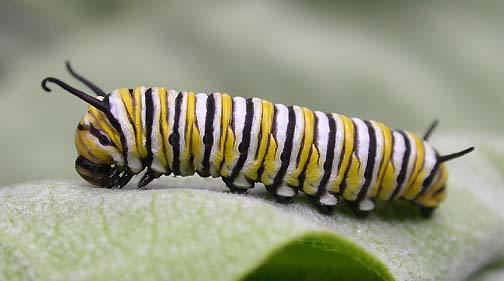July 26th, 2006
baby pictures from the research lab
On Monday, while making my insect watching rounds of the gardens, I found a tiny Monarch caterpillar on the underside of a Common Milkweed leaf. I find them around the farm quite frequently, but took particular note of this one because it was on almost the same spot where I found one on a Milkweed leaf last summer. That time, I considered bringing it indoors to raise on leaves as I know how often caterpillars are killed by predators such as some species of Stink bugs. However, I left the caterpillar where I found it, but visited it each day to keep a photographic record of its progress. Unfortunately, after several days, it was killed by a predatory Stink Bug.
This time, I decided to bring the Monarch caterpillar indoors and raise on leaves which I gather each day. It’s been in the house for 2 days now and has grown from about 15mm to 20 mm in length (that’s approx. 5/8 to about 3/4 of an inch in length). I simply change the leaves each day and keep the container clean and discard the frass (insect poop). It’s interesting to see how quickly a caterpillar grows. Hopefully, with a bit of luck, it will continue to grow without succumbing to the many things that can go wrong with a caterpillar before it pupates.
That’s about all I’m going to write about the caterpillar project for today. I’ll try to update the caterpillar’s progress — although, no guarantees — sometimes these projects don’t quite go according to plan.
Which brings me to another point — and that has to do with the farm and how I regard all of the insect activity that takes place here. Although entirely unofficial, I’ve come to think of the farm as one big research plot for insect and other nature study. Having lived here for about 30 years now, the history of this plot of land is well known to me. Also, having photographed insects at this site for four summers, I’ve gradually added to my knowledge of insect populations, habitat and behaviour. It’s been a fascinating learning experience — one that continues as new things are discovered with each passing day. I don’t think we can overestimate how much we can learn by paying attention to our surroundings, no matter how large or small the plot of land. New discoveries can be made in the smallest of backyards or gardens.
Tags: Monarch caterpillar

July 26th, 2006 at 7:05 pm
what a wonderful reminder of my youth. somewhere along between maybe eight and twelve years old i brought in both monarch caterpillars and chrysalises (hoping that’s the correct plural spelling). they almost always successfully hatched, er, emerged, as butterflies, which i released. i was not anywhere so careful about feeding them and cleaning the jar as you are tho.
roger
July 26th, 2006 at 8:03 pm
Is there an explanation for the colours they have? It certainly doesn’t seem very camofloug, but the yellow bright bands might be a warning to predators?
I’m glad you made the point about learning experiences. I think blogs like yours give a true appreciation which rubs off on people such as myself. I have certainly taken to searching for more information about the natural things I view and see in my surroundings, and view it all much differently then I did a year ago. It’s something I have always had an interest in since I was very young but didn’t have a community of people to share and learn with and highten the enthusiasm.
July 26th, 2006 at 10:18 pm
roger – Glad to have reminded you of something from your youth. There’s definitely something a little magical about caterpillars pupating and emerging as butterflies!
–
Peter – You know, it’s actually difficult to find Monarch caterpillars unless you’re looking for them, so the camouflage may be better than it seems. Milkweed leaves do turn yellow and the colour isn’t really all that far off from that of the yellow banding on these caterpillars. The younger ones are more subtle in colour and even more difficult to find than the adults (not to mention their small size).
I enjoyed your comments about blogs that communicate an appreciation for experiencing nature. I get the same thing out of visiting the blogs of others who write about nature and many other topics as well. I think that, collectively, these blogs create a community of people who can share their experiences and encourage others to write about their own discoveries.
July 27th, 2006 at 2:04 am
I would say, Bev, that it’s difficult to find them even when you are looking for them! I have better luck with swallowtail cats for some reason, maybe due to their fondness for more *feathery* plants, like dill or fennel.
July 27th, 2006 at 10:01 am
I was thinking about collecting some Monarch caterpillars but have not yet and have not seen as many lately as a few weeks ago. I really love the colours of the chrysalises and have slides, somewhere, but no digital images. I used to bring caterpillars into the grade one classroom at school when I still taught.
July 27th, 2006 at 11:47 am
OW – Yes, I love the chrysalises too. So intricate. I hope I’ll get to see this one when this caterpillar pupates. I just measured it this morning at it’s over 30mm now. Incredible how quickly they grow.
July 27th, 2006 at 2:00 pm
I guess they are more camoflaged then I thought, I don’t recall ever trying to seek one out, but I’ve stumbled onto them on quite a few occasions, usualy on something that would render the camo useless, like the side of a building.
July 27th, 2006 at 4:27 pm
Peter – Yes, they wouldn’t blend too well in that situation! (-: